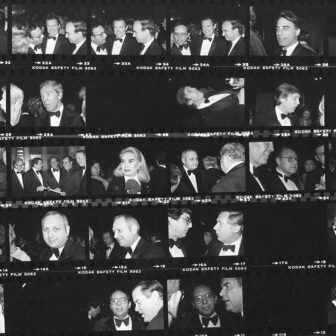Entirely predictably, the global campaign to expose alleged sexual predators in the entertainment industry has triggered a defamation action in the Australian courts. Given the mix of a Weinstein-charged media cycle, celebrity reputations, and treacherous defamation laws, it was only a matter of time. Geoffrey Rush, internationally acclaimed stage and screen actor and Oscar winner, is suing over a “world exclusive” published by Sydney’s Daily Telegraph.
The Telegraph’s exclusive relates to Rush’s turn as star of the 2015–16 Sydney Theatre Company production of King Lear. On 30 November, the paper led with a front-page photo of Rush in costume as King Lear, with the large headline “KING LEER.” Under this headline were the words “World Exclusive — Oscar-winner Rush Denies ‘Inappropriate Behaviour’ During Sydney Stage Show.” The paper’s Jonathon Moran said that Rush had been the subject of a complaint about “inappropriate behaviour” understood to have occurred “over several months” during production. The complaint was said to have been made to the STC by a complainant not identified in the report. The nature of the “inappropriate behaviour” was not specified.
The reporting continued inside the paper with a double-page spread carrying the large headline “STAR’S BARD BEHAVIOUR.” Moran reported that Rush had said through his lawyers that he hadn’t been advised of the nature of the claim and had not been approached by the STC or the complainant. On all pages, the actor’s denial of the claim was highlighted.
Outside newsagencies, the Tele’s billboard posters read: “World Exclusive: Geoffrey Rush in Scandal Claims, Theatre Company Confirms ‘Inappropriate Behaviour.’” Moran tweeted the “King Leer” page one and the Telegraph also tweeted the reports. Not surprisingly, the claims made global headlines.
The next day, the Telegraph ran with another report by Moran, headlined “We’re with You: Theatre Cast Back Accuser as Rush Denies ‘Touching.’” Here it was claimed that two actors in the Lear production had backed the complaint. One was quoted from his Facebook page: “I was in the show. I believe whoever has come forward. It’s time for Sydney Theatre Company and the industry in Australia and worldwide as a whole to make a stand on this behaviour!!!”
On Friday, Rush announced he was suing. Referring to the anxiety, hurt and distress experienced by himself and his family, he took aim at the Telegraph’s “false, pejorative and demeaning claims” and said he had no choice but to vindicate his reputation.
In his application to the Federal Court, the actor claims unquantified damages against the Telegraph and Moran for the “irreparable harm” to his reputation. These include damages for hurt and distress, for economic loss as a result of being shunned by future employers, and for “ridicule” arising out of the headlines.
While neither the paper nor Moran has yet filed a defence, it appears that the case will turn on the notoriously complex technical battles common in Australian defamation proceedings. The first stage will have little to do with whether the complaint against Rush had merit. Rather, it will be an extended tussle over the meanings to be derived, legally, from the publications. These are “objectively” determined by the court on the basis of a test of the “ordinary reasonable reader,” a person of reasonable intelligence who is “not avid for scandal.” That person is the proxy for what the general public are taken to have got from each of the publications complained of, and accordingly how defamatory they were.
This battle over meanings is critical because it sets the standard for determining what the Telegraph and its reporter must defend. The more serious the imputation found, the harder it will be to establish a defence. Accordingly, the usual practice of an applicant is to claim a range of meanings, cascading downwards in terms of seriousness, to ensure at least one sticks. In Rush’s case, the claims cascade from the general and highly defamatory claim of his being a “pervert” to the more specific “committed a sexual assault” and to the more modest, but still defamatory, claim that he engaged in “inappropriate behaviour against another person.”
A clue to the Telegraph’s line of defence came in a statement from the paper that it had done no more than report the fact that a complaint had been made against Rush. On this basis, the paper’s lawyers would argue that none of the meanings, or “imputations,” claimed by Rush arose. This is a difficult but crucial argument for a defendant in relation to reporting of this kind. The courts have taken a conservative view of what publishers can say about a person accused of misconduct. It is fairly easy for reporting to shade into suggestions that the person is actually guilty, or that there is a reasonable basis for the accusation. That will be a matter of impression for the court, again applying the “ordinary reasonable reader” test.
So difficult is it to tell how a party will fare in these technical rounds that they have been likened to a lottery. This is because they are determined on the basis of somewhat artificial rules. For example, while Rush is obviously very concerned by the lurid headlines on the Telegraph’s pages, the general rule is that a headline is not to be taken in isolation. The ordinary reasonable reader is deemed to have read the whole article, including Rush’s denials, rather than merely glancing at the headlines in the supermarket queue. Conversely, though, billboard posters and tweets tend to be viewed as separate publications of their own. The Telegraph may have to defend the billboard poster and any tweets of incomplete excerpts of the reports individually, as Fairfax Media had to do when it was sued by Joe Hockey in 2014.
If none of Rush’s argued meanings, or imputations, is shown to arise, then he loses the case and pays the Telegraph’s costs. If he can establish that one or more defamatory meanings did arise, the paper will have to respond to each with substantive defences. If Rush is able to establish that readers would have believed him to have committed a sexual assault on an actress during King Lear, that is what the Telegraph will have to prove, on the balance of probabilities, did occur. If Rush succeeds in establishing perhaps the most serious imputation, namely that he is a “pervert,” as he claims the publications imply, the Telegraph will have to show that he is one, having regard to the ordinary dictionary meaning of this term. If it can’t establish a defence to the imputations, it will be liable to pay what are likely to be very substantial damages.
One interesting aspect of this case is that Rush has filed in the Federal Court of Australia. Unlike defamation courts in New South Wales, the Federal Court is unlikely to allow a jury trial. It will most likely be a judge alone. This is a developing trend in defamation law, and may have to do with the perceived unpredictability of juries.
The claim will come to court in the new year. If it proceeds, it will be a spectacle worthy of the stage, and a reminder of the high stakes involved when sexual misconduct claims go public. ●




